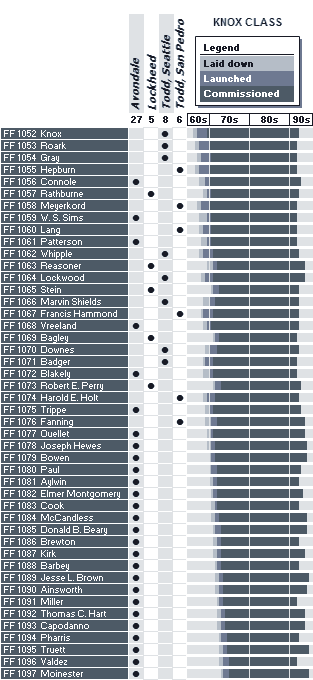

The Knoxes were the US Navy’s last destroyer-type design with a steam powerplant. In appearance, they were conspicuous for their tall, circular cross-section “macks.” They were wet forward, prompting modification with bow bulwarks and spray strakes for some ships. Most obviously, they were big: thanks in part to a late reversion to conventional 1,200 psi boilers, they gained 24 feet in overall length and twenty per cent in weight over the Garcias—which made them comparable in size to the Charles F. Adams-class guided missile destroyers and larger than the all-gun World War II and Forrest Sherman classes in the destroyer squadrons to which they were attached.
Length: 438' overall; 415' waterline.
Beam: 47'.
Draft: 15'.
Displacement: 3,020 long tons light; 4,065 long tons full load.
Propulsion machinery: 2 x 1,200 psi boilers; 1 geared turbine, 1 shaft; 35,000 shp.
Design speed: 27 knots.
Design complement: 13 officers; 211 enlisted.
Roomier than these destroyers, the Knoxes were generally liked by crews but naturally, as specialized ASW platforms, could not match their offensive capability. The Knoxes also lacked redundancy: their single screw made breakdown a concern and their lone 5-inch/54 could jam during continuous fire (embarrassing on the Vietnam gun line when they were new). Thus inviting and suffering from side-by-side comparison with the destroyers, they became known to a generation of destroyermen as “McNamara’s Folly.”
As they aged, however, their weapons and sensors evolved significantly. In 1971–75, 31 Knoxes received the basic point missile defense system (BDPMS). Downes was subsequently modified to carry Sea Sparrow surface-to-air missile launchers. Later, all ships were upgraded with the Phalanx Mk 16 close-in weapons system (CIWS). Also, the class’s stern-facing torpedo tubes were replaced by the SQS-35 variable depth sonar and the AN/SQR-18A TACTASS towed passive sonar array plus a LAMPS Mk I SH-2D Seasprite helicopter.
Thus enhanced, the seaworthy Knoxes enjoyed a 20–25-year service life in the US Navy until they were phased out in 1991–94, when the Soviet submarine threat collapsed and after the Oliver Hazard Perry-class frigates had arrived in numbers. Not yet done, some become the core of the Innovative Concept Reserve Training Program (ICRTC), available for reactivation on 180 days’ notice. Eventually, while 34 were transferred to Turkey (12), Taiwan (8), Mexico (4), Greece (3), Thailand and Egypt (2 each), nine were scrapped and six were sunk as targets.
Knox, herself, was the last to go—towed from Bremerton, where she had been laid up, to Guam and sunk there in the summer of 2007.